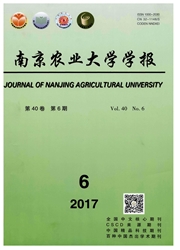

 中文摘要:
中文摘要:
采用ISSR分子标记技术,从80个随机引物中筛选出多态性强、重复性好且稳定性高的引物15个,对37份鸢尾属材料进行多态性分析,共扩增出328条带,多态性带为327条,多态性比例达99.7%,说明鸢尾属物种间有丰富的遗传多样性。依据15个有效引物所产生的328条ISSR标记建立DNA分子系统聚类图,将供试材料分为6组,其中矮紫苞鸢尾和单苞鸢尾单独划为一组。根据获得物种特有ISSR标记分析表明,利用15个有效引物可以较好地将鸢尾属供试37份材料区分开,其中7个材料具有各自特有的扩增带,单苞鸢尾和黄菖蒲还分别具有2和3条各自特有的扩增带,仅引物ISSR8、ISSR63和ISSR75即可将所有37份供试材料区分开。
 英文摘要:
英文摘要:
ISSR molecular markers were used to detect the genetic diversity among 37 Iris L.materials.15 primers which could produce clear,polymorphic and steady bands,screened out of 80 random primers,were used and produced 328 bands totally.Of them 327 bands(99.7%)were polymorphic,which indicated that the genetic diversity of Iris L.was rich.A DNA molecular dendrogram was established basing on 328 bands amplified by 15 primers,from which it showed that the 37 Iris L.were divided into six groups,and meanwhile,I.ruthenica var.nana and I.anguifuga were in one group.The results indicated that the 37 Iris L.materials could be differentiated by the 15 primers easily.There were 7 materials having their own ISSR markers.I.anguifuga and I.pseudacorus had 2 and 3 unique ISSR markers severally,and with the three primers of ISSR8,ISSR63 and ISSR75,37 materials could be differentiated easily.
 同期刊论文项目
同期刊论文项目
 同项目期刊论文
同项目期刊论文
 期刊信息
期刊信息
